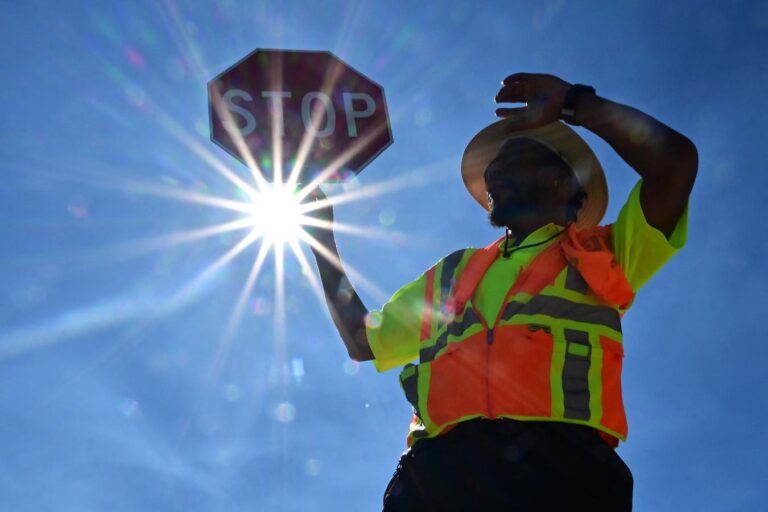Heat stress can pose a serious health risk to the world’s estimated 32 million outdoor workers. … [+]
If you haven’t experienced it, let me warn you: It’s hot, really hot, across most of the country. According to the National Oceanic and Atmospheric Administration, there’s a 61 percent chance that 2024 will be the hottest year on record and likely one of the top five hottest years on record. With our summer months set to continue to warm, the likelihood of extreme heat events has many businesses rethinking their strategies for keeping their employees safe and productive.
As predicted earlier this year, a heat dome blanketed much of the country, bringing dangerously high temperatures to many Americans throughout the month of June. Extreme heat and humidity are a leading cause of weather-related death in the United States, resulting in hundreds of deaths each year. Last year, 2,300 people died from the effects of excessive heat, and nearly 120,000 people visited the emergency room due to heat stress.
Impact of heat on workers’ health
Heat stress can pose a serious health risk to the estimated 32 million outdoor workers in the United States, particularly in industries such as construction, landscaping, and agriculture. The U.S. Department of Health and Human Services cites a study that found that agricultural workers are 35 times more likely than the general population to die from heat exposure. But outdoor workers aren’t the only ones at risk from heat exposure; those who work in warehouses, bakeries, and similar environments also face heat-related risks.
Some industries have regulatory requirements for managing heat stress. For example, the Occupational Safety and Health Administration (OSHA) provides guidelines for preventing heat-related illnesses and deaths among outdoor workers. But many industries lack standard safety protocols for extreme heat where regulations don’t apply. That makes it all the more critical to understand and recognize extreme heat threats before they become a serious health risk.
Extreme heat hurts productivity
Extreme heat also impacts productivity. In 2021, more than 2.5 billion hours (about 290,000 years) of outdoor work were lost due to heat exposure in the United States, which could cost the U.S. economy up to $100 billion. States and cities are also feeling the pinch. In Texas, research shows that the economy is particularly vulnerable to hotter summers, and for every one-degree increase in average summer temperatures, Texas’ annual GDP growth slows by 0.4 percentage points.
So what can businesses and workers do when the thermometer is showing record temperatures and meteorologists are predicting them? Use the power of weather data to plan and prepare.
Using weather data to manage heat risks
Businesses can leverage weather data technology to improve risk awareness and develop and implement heat risk management strategies, including training programs and safety protocols.
Access to weather analytics is one of the most underutilized but readily available resources an organization’s security team can use to prepare for potential extreme heat events.
While extreme weather conditions such as tornadoes or severe thunderstorms are often associated with real-time radar and storm tracking information, those seeking information on larger, longer-term weather events such as extreme heat can also benefit from longer-term forecasts and the use of weather analytics. Integrating weather information into an organization’s security management can help leaders make more informed decisions based on real-time information and forecasts.
Understanding Wet Bulb Globe Temperature
The Occupational Safety and Health Administration guidelines recommend using a wet bulb temperature (WBGT) monitor to measure ambient heat in the workplace. For outdoor workers, knowledge of WBGT can inform a critical assessment of heat stress and is necessary to ensure employee safety in high temperatures. Most people are familiar with the heat index and the perceived temperature it provides by calculating humidity and temperature in shaded areas to determine the effect of temperature on people outdoors. But a more accurate way to measure heat stress on the body is the wet bulb temperature (WBGT). The WBGT calculation incorporates several factors, including direct sunlight temperature, humidity, sun angle, wind speed, and cloud cover. Each factor plays a crucial role in determining heat stress on the human body. For example, when extreme heat combines with high humidity and light winds, it can become riskier than expected because the body’s natural cooling mechanism does not work as effectively.
While temperatures will fluctuate from coast to coast, the recent warming trend shows no signs of slowing as we approach summer. With high temperatures showing no signs of abating across the country, heat will be a pressing issue for employees working both indoors and outdoors. Actions can be taken now, such as recognizing the symptoms of heat-related illness and knowing how to prevent them, or using the WBGT and other data to make informed decisions about how to ensure the safety and well-being of their workforce.


